The musicians are floating in space. The middle of their bodies is missing and only their conical hats and the cloth that covers their folded legs allow the viewer to piece them together into human shapes. The instruments are more clear: the xylophone, the gongs, drums, and something that looks like a trumpet. Below the orchestra are seven flowers, their purpose still unclear.
This is one of more than 200 images that were recently revealed on the walls of Angkor Wat, Cambodia’s most famous tourist attraction. The images have probably been there for hundreds of years, but until a cave painting specialist decided to take a closer look, no one paid much attention. Of the ancient orchestra, the only part that anyone could see on the grey wall was a gong – if anyone could determine what it was, that it is – for it may as well have been a donut hanging on a string.
___________________________________________
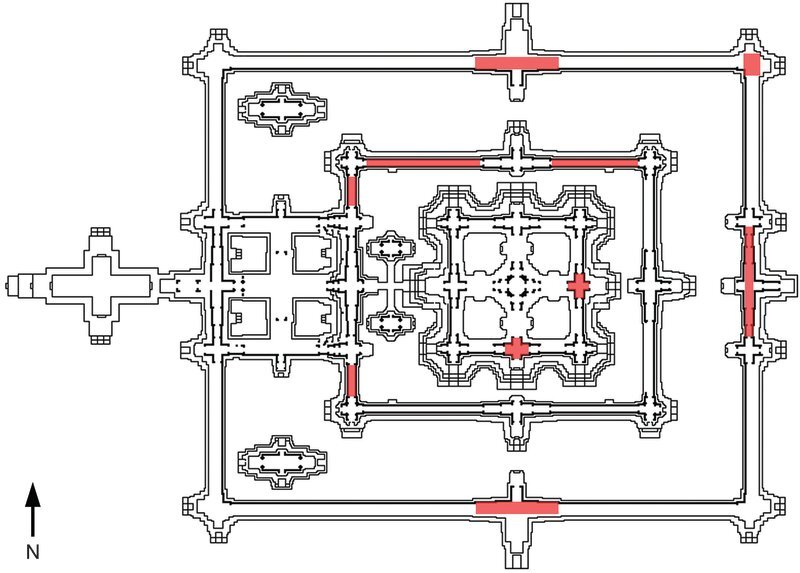
Plan of Angkor Wat central structure/complex, showing locations of the paintings. The paintings on the outer wall are not marked. Courtesy Noel Hidalgo Tan and Antiquity Publications Ltd.
___________________________________
 Above, as seen with naked eye on the structure wall, and below, the computer-enhanced version: The pinpeat or Khmer orchestral ensemble, consisting of various gongs and drums. The hanging gongs on the left are visible without enhancement. Courtesy Noel Hidalgo Tan and Antiquity Publications Ltd.
Above, as seen with naked eye on the structure wall, and below, the computer-enhanced version: The pinpeat or Khmer orchestral ensemble, consisting of various gongs and drums. The hanging gongs on the left are visible without enhancement. Courtesy Noel Hidalgo Tan and Antiquity Publications Ltd.
_______________________________
“I’m very accustomed to looking for traces of paint on rocks,” explains Singaporean archeologist Noel Hidalgo Tan, a Ph.D. student at Australian National University, who found the images after volunteering on an excavation project at Angkor. “On one of the lunch breaks, I was wandering around the temples, and I saw traces of red paint on walls and decided to take a few photos.”
When Tan ran the photos through a special computer program that enhances contrast, he saw more than 200 black and red pictures – approximately half of which had never been seen before, he said. His research was published in the UK journal “Antiquity” this year. (See Image Gallery below for selected images).
“[After the computer analysis] I realized the paintings were quite elaborate – and you can barely see anything on the walls. I didn’t think it was a new discovery. I thought everyone knew about the paintings,” he said.
But it turned out that while some of the paintings were known to the local people, they had never before been systematically documented.
“It’s a kind of art history that we didn’t have previously,” says American archaeologist Miriam Stark, who is the co-investigator on the Greater Angkor project. “Finding this kind of patterning beneath our noses is a great contribution.”
The images ranged in size from a large 2 by 5 meter painting depicting the Buddha on the ancient temple’s ceiling to smaller images that were probably left behind by pilgrims rather than professional artists. Here computer analysis revealed men on horseback, elephants, lions, horses, buildings, and boats – as well as Angkor Wat itself. Still other images Tan describes as graffiti: they include handprints. Some pictures were hard to interpret. “There are figures and I don’t know what they mean,” Tan says.
Much research remains to be done to determine the age of paintings. Because the likeness of the Buddha is seen in a large painting—the image depicts a man seated in a meditation pose with something that looks like a crown on his head—Tan believes that the oldest images may go back to the 16th century, or the reign of Cambodian King Ang Chan I, who moved his capital back to Angkor and began transforming the Hindu temples into Buddhist sites.
“That is our best estimate currently,” he says. “It seems logical.”
___________________________________
 The computer-enhanced Buddha image. Courtesy Noel Hidalgo Tan and Antiquity Publications Ltd.
The computer-enhanced Buddha image. Courtesy Noel Hidalgo Tan and Antiquity Publications Ltd.
_________________________________
Another clue comes from the image of a European sailboat—there were no sailboats in Angkor, only row boats. The sailboat looks like it might be from the 18th century, the researchers say. And, Tan says, we know that the images are at least a hundred years old because some of them can be seen in French photographs from the 1920s.
One way to find out for sure how old the paintings are would be to carbon-date the paint. However, this would only work if the paint was made from an organic material, such as a plant resin. The pigment in the pictures hasn’t been analyzed yet to determine what it is made from, and no one has stepped forward to carbon-date the paint yet, Tan said.
The orchestra
Tan says his favorite image is the ancient orchestra—a picture that also attracted the attention of Patrick Kersale, a French ethnomusicologist who rebuilds historic musical instruments.
According to Kersale, the image is the oldest depiction of a xylophone that has ever been seen in Cambodia. The xylophone was unknown during the height of the Angkorian empire, and must have been imported to the region from Malaysia in the centuries after the decline of Ankgor, Kersale says.
“You can find musical instruments on the bar reliefs [of Angkor] from the seventh to the 13th century. Most musical instruments [in Angkor] came from India,” he said. “But in the 16th century, we have a new instrument not coming from India, but coming from Malaysia. There is no xylophone in India.”
The trumpet is also intriguing, as there are no trumpets in modern-day Cambodian orchestras—although the instrument existed in Angkor in the 9th century, Kersale said. In ancient times, the trumpet (which is visible on Angkor’s bar reliefs and has the shape of a sea monster, Kersale says) may have been used to call worshippers to religious ceremonies, he said.
“This is the first time we see a long trumpet [in Cambodia]” he said. “It looks like a trumpet we find in the Kathmandu valley of Nepal.”
Finally, the gong chime in the picture has eight gongs, which is also unusual. Currently, Cambodian orchestras use gong chimes with 16 gongs, while the ones during Angkorian times had fewer than eight.
“Maybe this instrument evolved from the 16th century,” Kersale says.
The orchestra itself resembles a type of musical ensemble that traditionally plays at Cambodian funerals.
____________________________________
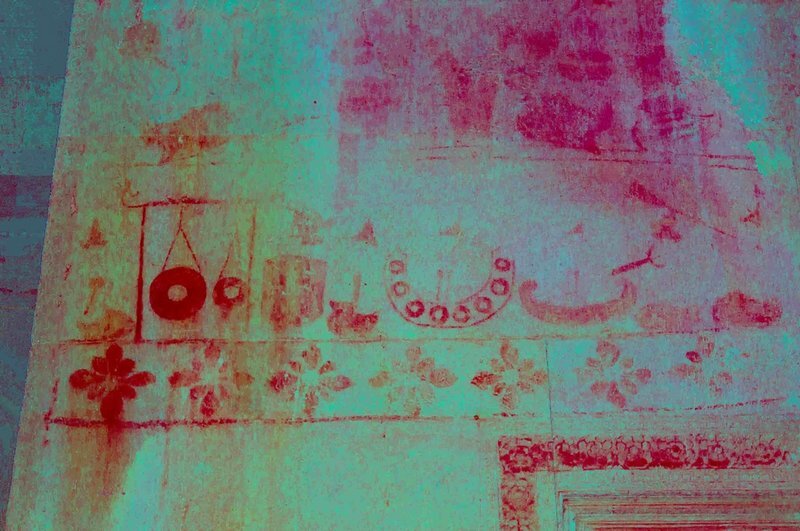 The Khmer orchestral ensemble (computer-enhanced). Courtesy Noel Hidalgo Tan and Antiquity Publications Ltd.
The Khmer orchestral ensemble (computer-enhanced). Courtesy Noel Hidalgo Tan and Antiquity Publications Ltd.
_________________________________
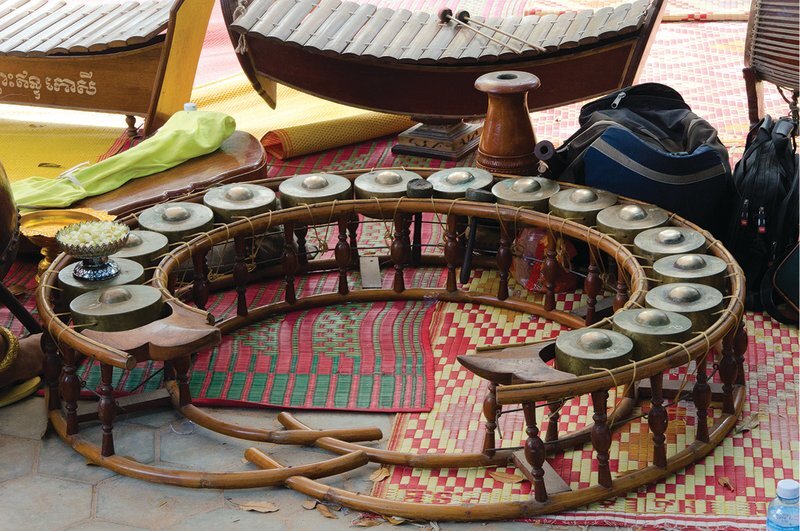 Pinpeat instruments in Siem Reap. Note the similarity of the kongvong (gongs set in a semi-circular frame) and roneat (metal or bamboo xylophones) to the forms in painting above. Courtesy Noel Hidalgo Tan and Antiquity Publications Ltd.
Pinpeat instruments in Siem Reap. Note the similarity of the kongvong (gongs set in a semi-circular frame) and roneat (metal or bamboo xylophones) to the forms in painting above. Courtesy Noel Hidalgo Tan and Antiquity Publications Ltd.
_______________________________
Kersale is currently working on rebuilding the orchestra from the painting, and plans to hold regular concerts at a pagoda in Siem Reap, the touristy town near Angkor Wat, starting in November. All the instruments will be built in Cambodia, except for the trumpet, which he plans to bring from Nepal, since Khmer instrument-makers no longer have the skills to make a trumpet, he said.
While one can rebuild ancient instruments, it’s unfortunately impossible to recreate the melodies that Khmer musicians produced on these instruments hundreds of years ago, Kersale said.
Is it really a new discovery?
According to Im Sokrithy, the head of the communications department for Cambodia’s Authority for the Protection and Management of Angkor (APSARA), the paintings have always been known to the local people and could be seen with the naked eye.
“The paintings existed there. The local people know [about them], the Khmer researchers know, but we had no opportunities to publish it in the world-wide journals because the sculpture dominated everything,” he said. “The value (of the paintings) cannot compare with the value of the sculpture. That’s why we ignored it.”
Computer analysis only made the images clearer and more beautiful, he says.
“One image might be of two horses, but with the naked eye we cannot see that there are two. We can only see one,” he says. “Or some image might show a big elephant—with the naked eye we can see just a shape, but with the computer we can see some ornaments, some details on the head of the elephant.”
But Damian Evans, an Australian archaeologist who works in Angkor, said Tan’s work was very significant.
“Certainly if people had seen all the paintings then they never published that information, so the key thing really is that no one had gone through and done the proper documentation and analysis before,” he stated.
Meanwhile, Hawaii-university’s archaeology professor Stark compared Tan’s research to the impact 19th century French traveler Henri Mouhot had when he “discovered” Angkor Wat. While it’s true that Angkor Wat was known all along to the local residents in Cambodia, when Mouhot wrote about it, he revealed it to the world. That’s why Tan’s work is “a huge contribution,” she said.
“Only the boat paintings were clearly visible before. The only attention was by nautical archaeologists,” she said. “To convert some sort of knowledge to this academic currency makes it available to the rest of the world, makes it really important.”
____________________________________
Image Gallery
 One of the known boat paintings on the outer wall of Angkor Wat. Note the red paint on the apsara carvings, which is commonly seen in similar carvings inside the temple.
One of the known boat paintings on the outer wall of Angkor Wat. Note the red paint on the apsara carvings, which is commonly seen in similar carvings inside the temple.
____________________________________________
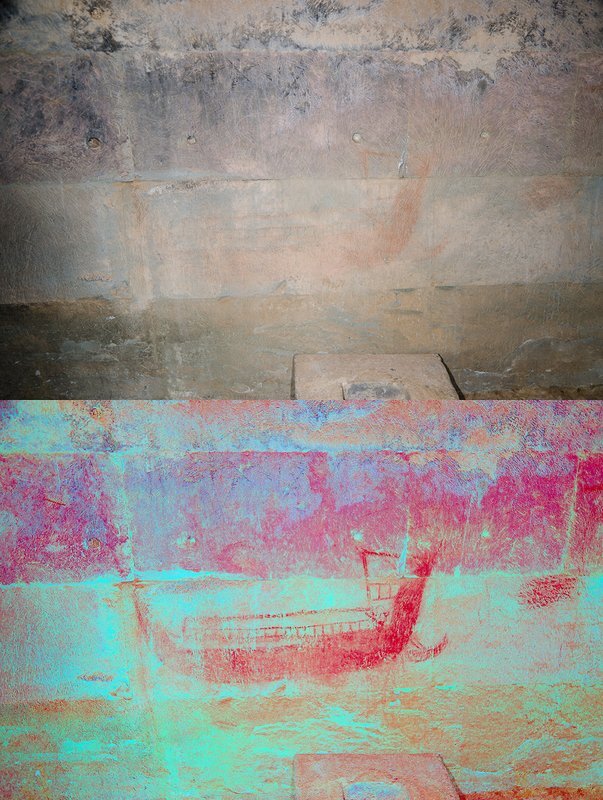 Enhanced boat painting
Enhanced boat painting
________________________________________________
 Enhanced painting of elephants
Enhanced painting of elephants
__________________________________________
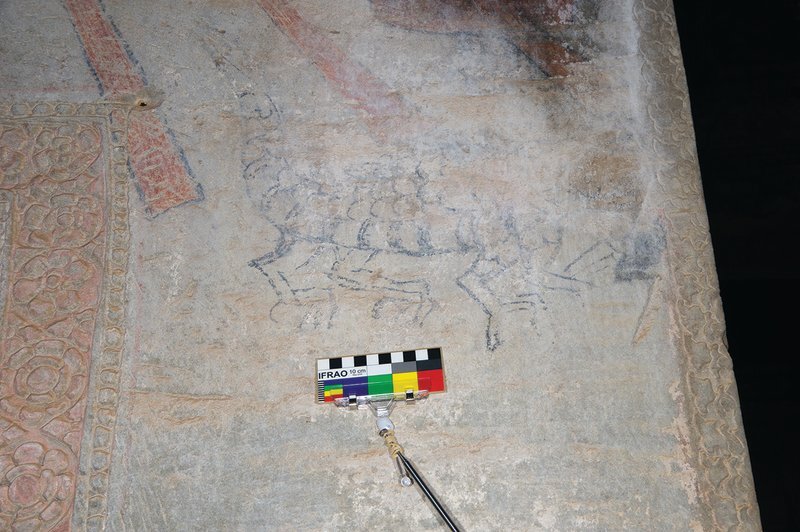 Black drawing of a zoomorph with scales and multiple legs
Black drawing of a zoomorph with scales and multiple legs
________________________________________
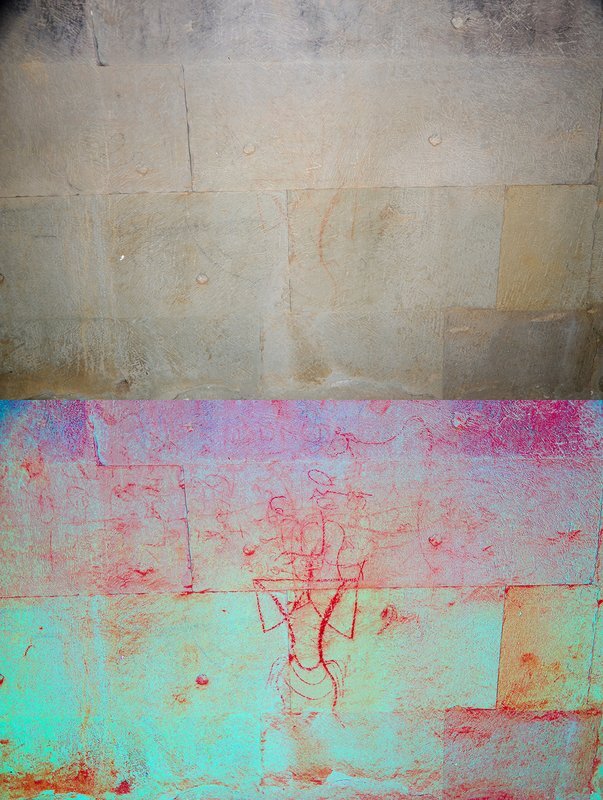 Enhanced line painting of a figure with hands set in a praying position, possibly a preliminary sketch of an apsara
Enhanced line painting of a figure with hands set in a praying position, possibly a preliminary sketch of an apsara
_________________________________________
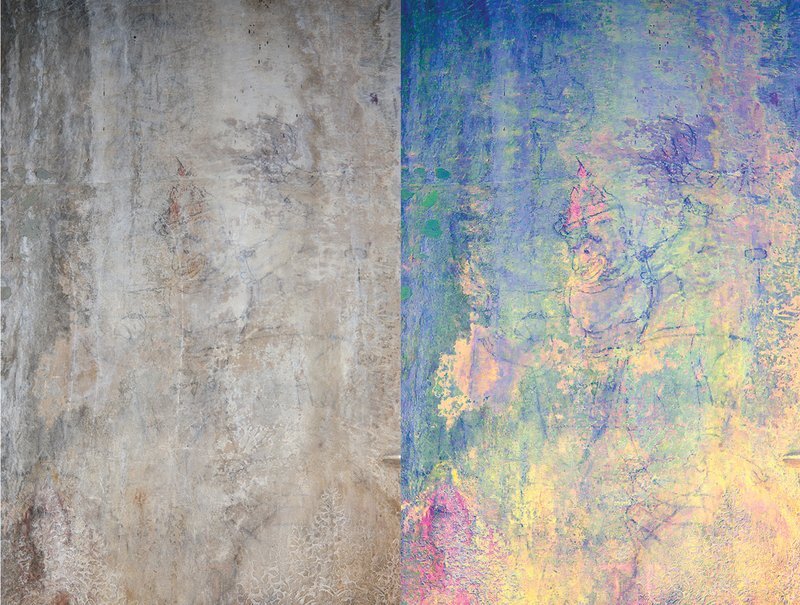 Black line drawing of Hanuman, the monkey king
Black line drawing of Hanuman, the monkey king
_____________________________________________
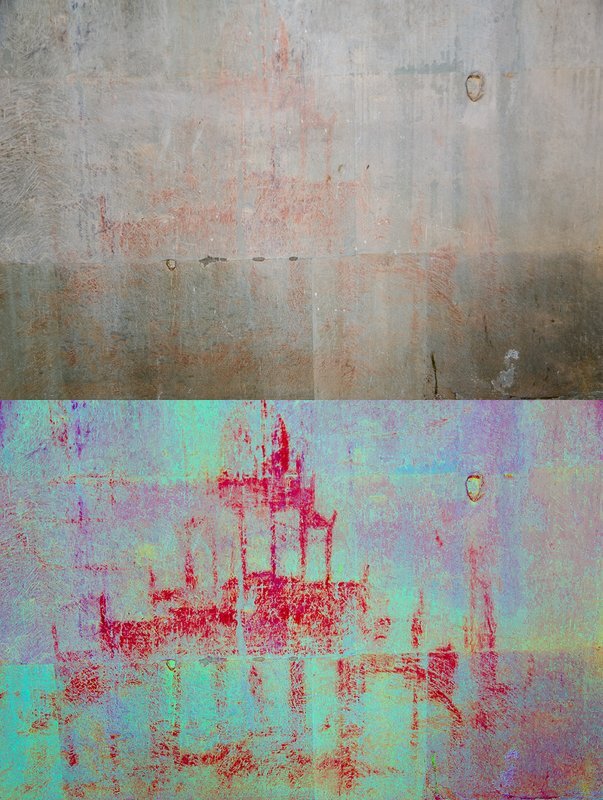 Enhanced painting of a stepped pyramid structure, possibly a depiction of Angkor Wat itself. Note the mirror image of the building in the lower register, as if depicting a reflection on water.
Enhanced painting of a stepped pyramid structure, possibly a depiction of Angkor Wat itself. Note the mirror image of the building in the lower register, as if depicting a reflection on water.
_____________________________________________
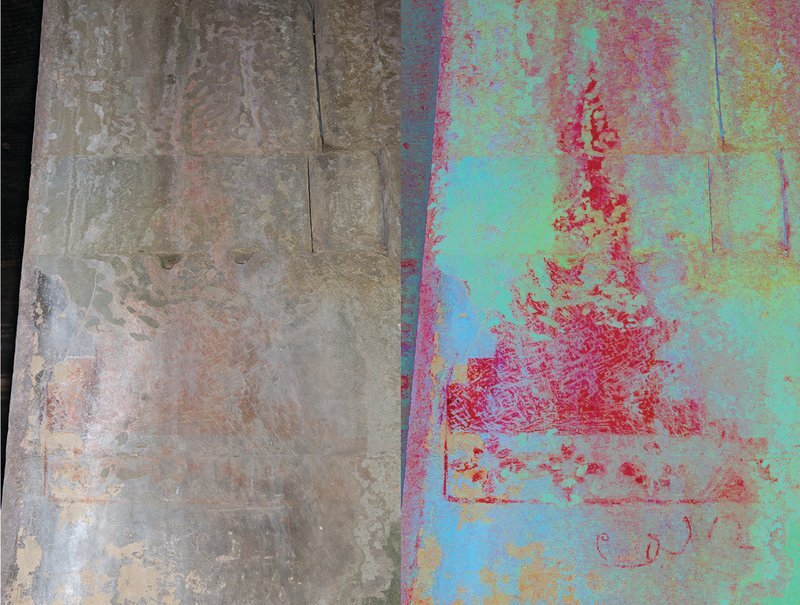 Possible depiction of a stupa
Possible depiction of a stupa
___________________________________________
 A pinpeat or Khmer orchestral ensemble, consisting of various gongs and drums. The hanging gongs on the left are visible without enhancement.
A pinpeat or Khmer orchestral ensemble, consisting of various gongs and drums. The hanging gongs on the left are visible without enhancement.
____________________________________________
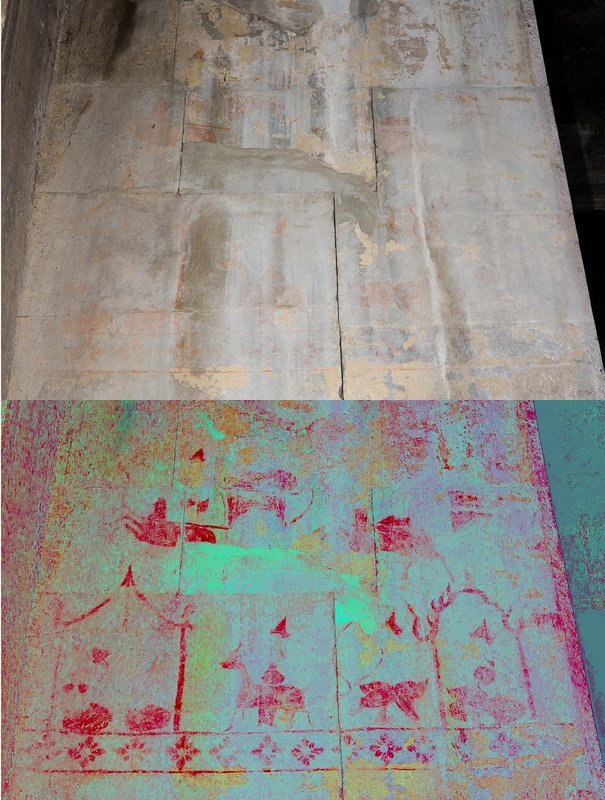 Elaborate scene featuring riders on horses travelling between two possible temple structures
Elaborate scene featuring riders on horses travelling between two possible temple structures
________________________________________________
All images courtesy Noel Hidalgo Tan and Antiquity Publications Ltd.
________________________________________________
A R T I C L E S U P P L E M E N T
Southeast Asian Rock Paintings
Other than revealing the hidden paintings on the walls of the world’s largest religious monument, Singaporean archeologist Noel Hidalgo Tan has been studying prehistoric rock paintings all over Southeast Asia. In fact, he is the expert on Southeast Asian cave paintings.
“I got interested in rock art because no one was really studying rock art. It seemed like a good area of research to go into,” he said. “There are paintings on rocks throughout Southeast Asia, but no one bothered to study them before.”
Tan is currently doing research on a number of sites in Cambodia, including in Phnom Kulen, where he is studying red images on rock shelters depicting fish, cows and people. He believes that the paintings might go back thousands of years.
“In Australia, we have paintings that are 40,000 years old. Everyone who came to Australia had to make their way through Southeast Asia—so you expect to find cave paintings in Southeast Asia as old as in Australia,” he says.
In Cambodia, cave paintings have only been found in the last ten years, because no one has been looking. Everyone was focused on the temples of Angkor, Tan says.
The images on Cambodian rock ledges are red and black—and researchers know that the black paintings are younger because they are on top of the red pictures, Tan says. This, according to Tan, is a Southeast Asian trend: black paintings are always on top of the red ones.
Interestingly, the images Tan found on the walls of Angkor Wat were also done in red and black.
“That’s an interesting question—that the colors of Angkor Wat are the same as colors on the cave walls,” he said. “It would be interesting to compare.”
So what’s the difference between European and Southeast Asia rock paintings?
While both might go back 40,000 years, the European paintings are often found in deep and dark caves, while the Southeast Asian images are on rock ledges and cliffs, Tan said.
__________________________________
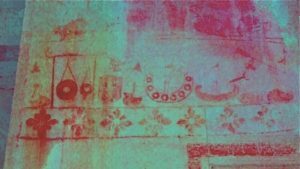
 Above, as seen with naked eye on the structure wall, and below, the computer-enhanced version: The pinpeat or Khmer orchestral ensemble, consisting of various gongs and drums. The hanging gongs on the left are visible without enhancement. Courtesy Noel Hidalgo Tan and Antiquity Publications Ltd.
Above, as seen with naked eye on the structure wall, and below, the computer-enhanced version: The pinpeat or Khmer orchestral ensemble, consisting of various gongs and drums. The hanging gongs on the left are visible without enhancement. Courtesy Noel Hidalgo Tan and Antiquity Publications Ltd. The computer-enhanced Buddha image. Courtesy Noel Hidalgo Tan and Antiquity Publications Ltd.
The computer-enhanced Buddha image. Courtesy Noel Hidalgo Tan and Antiquity Publications Ltd. The Khmer orchestral ensemble (computer-enhanced). Courtesy Noel Hidalgo Tan and Antiquity Publications Ltd.
The Khmer orchestral ensemble (computer-enhanced). Courtesy Noel Hidalgo Tan and Antiquity Publications Ltd. Pinpeat instruments in Siem Reap. Note the similarity of the kongvong (gongs set in a semi-circular frame) and roneat (metal or bamboo xylophones) to the forms in painting above. Courtesy Noel Hidalgo Tan and Antiquity Publications Ltd.
Pinpeat instruments in Siem Reap. Note the similarity of the kongvong (gongs set in a semi-circular frame) and roneat (metal or bamboo xylophones) to the forms in painting above. Courtesy Noel Hidalgo Tan and Antiquity Publications Ltd. One of the known boat paintings on the outer wall of Angkor Wat. Note the red paint on the apsara carvings, which is commonly seen in similar carvings inside the temple.
One of the known boat paintings on the outer wall of Angkor Wat. Note the red paint on the apsara carvings, which is commonly seen in similar carvings inside the temple.  Enhanced painting of elephants
Enhanced painting of elephants Black drawing of a zoomorph with scales and multiple legs
Black drawing of a zoomorph with scales and multiple legs Enhanced line painting of a figure with hands set in a praying position, possibly a preliminary sketch of an apsara
Enhanced line painting of a figure with hands set in a praying position, possibly a preliminary sketch of an apsara Black line drawing of Hanuman, the monkey king
Black line drawing of Hanuman, the monkey king Enhanced painting of a stepped pyramid structure, possibly a depiction of Angkor Wat itself. Note the mirror image of the building in the lower register, as if depicting a reflection on water.
Enhanced painting of a stepped pyramid structure, possibly a depiction of Angkor Wat itself. Note the mirror image of the building in the lower register, as if depicting a reflection on water.  A pinpeat or Khmer orchestral ensemble, consisting of various gongs and drums. The hanging gongs on the left are visible without enhancement.
A pinpeat or Khmer orchestral ensemble, consisting of various gongs and drums. The hanging gongs on the left are visible without enhancement. Elaborate scene featuring riders on horses travelling between two possible temple structures
Elaborate scene featuring riders on horses travelling between two possible temple structures






